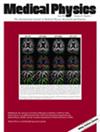Radiogenomic explainable AI with neural ordinary differential equation for identifying post-SRS brain metastasis radionecrosis
Abstract
Background
Stereotactic radiosurgery (SRS) is widely used for managing brain metastases (BMs), but an adverse effect, radionecrosis, complicates post-SRS management. Differentiating radionecrosis from tumor recurrence non-invasively remains a major clinical challenge, as conventional imaging techniques often necessitate surgical biopsy for accurate diagnosis. Machine learning and deep learning models have shown potential in distinguishing radionecrosis from tumor recurrence. However, their clinical adoption is hindered by a lack of explainability, limiting understanding and trust in their diagnostic decisions.
Purpose
To utilize a novel neural ordinary differential equation (NODE) model for discerning BM post-SRS radionecrosis from recurrence. This approach integrates image-deep features, genomic biomarkers, and non-image clinical parameters within a synthesized latent feature space. The trajectory of each data sample towards the diagnosis decision can be visualized within this feature space, offering a new angle on radiogenomic data analysis foundational for AI explainability.
Methods
By hypothesizing that deep feature extraction can be modeled as a spatiotemporally continuous process, we designed a novel model based on heavy ball NODE (HBNODE) in which deep feature extraction was governed by a second-order ODE. This approach enabled tracking of deep neural network (DNN) behavior by solving the HBNODE and observing the stepwise derivative evolution. Consequently, the trajectory of each sample within the Image-Genomic-Clinical (I-G-C) space became traceable. A decision-making field (F) was reconstructed within the feature space, with its gradient vectors directing the data samples’ trajectories and intensities showing the potential. The evolution of F reflected the cumulative feature contributions at intermediate states to the final diagnosis, enabling quantitative and dynamic comparisons of the relative contribution of each feature category over time. A velocity curve was designed to determine key intermediate states (locoregional ∇F = 0) that are most predictive. Subsequently, a non-parametric model aggregated the optimal solutions from these key states to predict outcomes.
Our dataset included 90 BMs from 62 NSCLC patients, and 3-month post-SRS T1+c MR image features, seven NSCLC genomic features, and seven clinical features were analyzed. An 8:2 train/test assignment was employed, and five independent models were trained to ensure robustness. Performance was benchmarked in sensitivity, specificity, accuracy, and ROCAUC, and results were compared against (1) a DNN using only image-based features, and (2) a combined “I+G+C” features without the HBNODE model.
Results
The temporal evolution of gradient vectors and potential fields in F suggested that clinical features contribute the most during the initial stages of the HBNODE implementation, followed by imagery features taking dominance in the latter ones, while genomic features contribute the least throughout the process. The HBNODE model successfully identified and assembled key intermediate states, exhibiting competitive performance with an ROCAUC of 0.88 ± 0.04, sensitivity of 0.79 ± 0.02, specificity of 0.86 ± 0.01, and accuracy of 0.84 ± 0.01, where the uncertainties represent standard deviations. For comparison, the image-only DNN model achieved an ROCAUC of 0.71 ± 0.05 and sensitivity of 0.66 ± 0.32 (p = 0.086), while the “I+G+C” model without HBNODE reported an ROCAUC of 0.81 ± 0.02 and sensitivity of 0.58 ± 0.11 (p = 0.091).
Conclusion
The HBNODE model effectively identifies BM radionecrosis from recurrence, enhancing explainability within XAI frameworks. Its performance encourages further exploration in clinical settings and suggests potential applicability across various XAI domains.

 求助内容:
求助内容: 应助结果提醒方式:
应助结果提醒方式:


